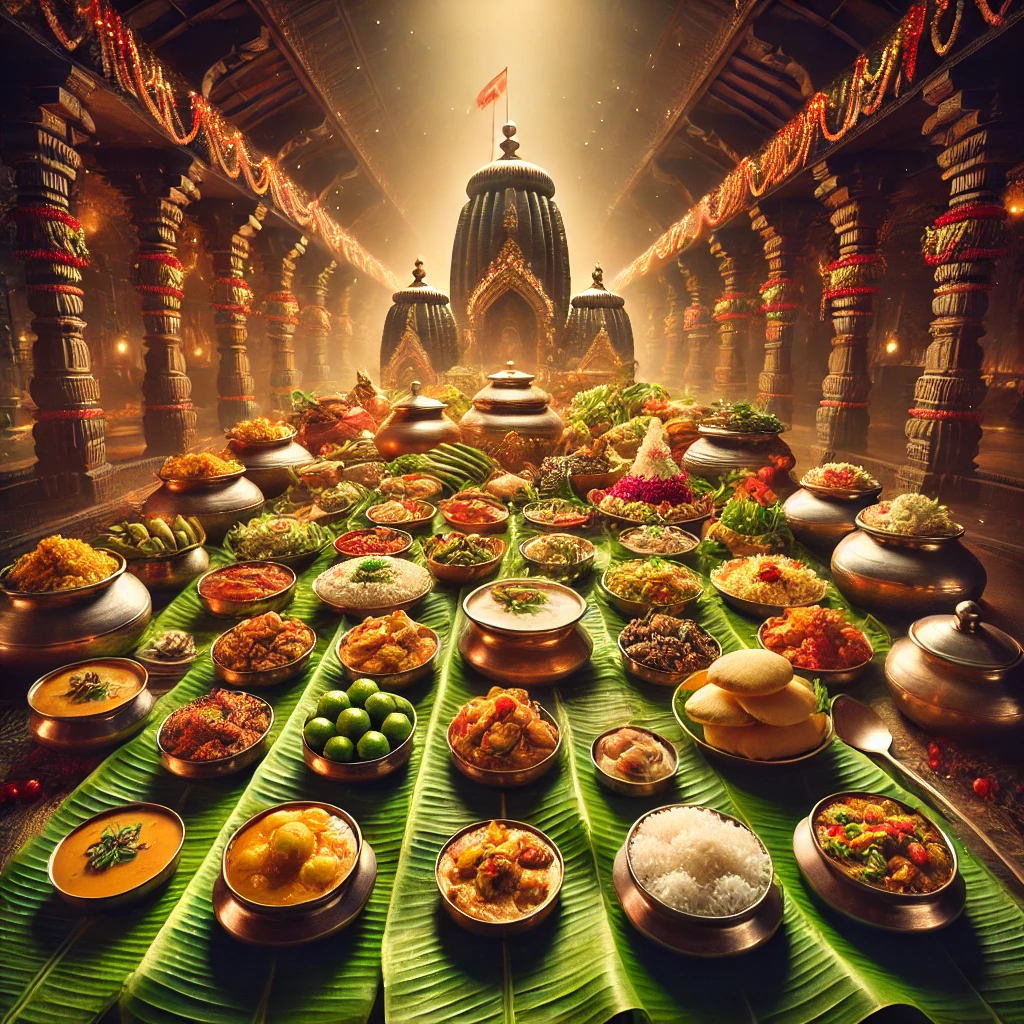
Mahaprasad recipe of jagannath temple
Prasadam: Sacred Food Offerings in Temples
Prasadam, derived from the Sanskrit word “Prasada”, means “grace” or “divine favor.” It refers to any offering made to a deity that is later distributed among devotees as a sign of blessings. In Sanatan Dharma, prasadam plays a significant role in bridging the gap between the mortal and the divine. It is a symbol of spiritual nourishment, purity, and the benevolence of the gods. Whether a simple offering like Panchamrit or a grand preparation like Mahaprasad or Tirupati Laddu, each variety of prasadam has its unique preparation methods, cultural context, and spiritual significance.
Temple kitchens across India are a reflection of ancient traditions, culinary skills, and the concept of seva (service). These sacred foods, prepared with devotion and purity, embody the spirit of Anna Brahma—the belief that food is not just sustenance but a sacred manifestation of divinity.
Tirupati Laddu – The Sweet Blessing from Lord Venkateswara
Origin: The Tirupati Laddu, one of the most renowned prasadam offerings in India, is distributed at the Tirumala Venkateswara Temple in Andhra Pradesh. The temple, which sees millions of devotees annually, has made the laddu synonymous with divine blessings.
Preparation: The Tirupati Laddu is prepared in an elaborate and traditional manner. It is made in the temple’s kitchens known as Potu, where cleanliness and sanctity are maintained with strict discipline.
Ingredients: Besan (gram flour), pure cow ghee, sugar, cashews, cardamom, and raisins.
Process: The ingredients are mixed and cooked meticulously to create a fragrant, soft, and rich laddu. Devotees receive the laddu in its distinct spherical shape as part of Naivedyam (offering).
The Potu follows centuries-old practices and serves as a model for large-scale cooking without compromising on quality or sanctity. The production of laddus has been scaled up to meet the growing demand while preserving the sacred methods.
Spiritual Significance: The laddu is considered Venkateswara Swamy’s direct blessing. It signifies divine sweetness and is believed to bring prosperity, fulfillment, and liberation from past sins. Receiving and consuming the laddu establishes a sacred bond between the deity and the devotee.
Table of Contents
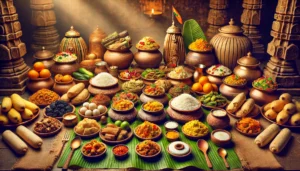
Mahaprasad recipe of jagannath temple
Mahaprasad of Jagannath Temple, Puri – Food for the Soul
Origin: The Mahaprasad offered at the Jagannath Temple in Puri, Odisha, is unparalleled in its scale and spiritual essence. Known as Chappan Bhog (56 offerings), it reflects the temple’s legacy of serving the divine and humanity. Lord Jagannath is often referred to as the “Bhoga-loving God”, making food a central aspect of the temple rituals.
Preparation: Mahaprasad is prepared in the Ananda Bazar or the temple kitchen, regarded as the world’s largest sacred kitchen. The process follows unique rituals:
Ingredients: Rice, lentils, vegetables, ghee, jaggery, and sweets are used. Onion, garlic, and artificial additives are strictly avoided.
Cooking Method: The food is cooked in earthen pots placed on traditional wood-fired clay stoves. The pots are stacked on top of each other, and a divine phenomenon ensures the top pot cooks first, despite the fire being at the bottom.
Significance: The Mahaprasad is considered the Lord’s offering of love to devotees. It is first served to Lord Jagannath, Balabhadra, and Subhadra, after which it is distributed to pilgrims. Consuming Mahaprasad is believed to cleanse sins and connect one’s soul to the divine. Moreover, it symbolizes equality and unity, as everyone, regardless of caste or status, partakes in the prasadam together.
Panchamrit – Nectar of Purity and Spiritual Cleansing
Origin: Panchamrit, meaning “five nectars,” is one of the simplest yet most profound offerings in Hindu rituals. It is used during Abhishekam (ceremonial bathing) of deities and as Naivedyam during pujas. The preparation and distribution of Panchamrit emphasize purity, nourishment, and the divine energy contained within sacred ingredients.
Preparation: The five ingredients represent natural purity and have symbolic meanings:
Milk – Purity, compassion, and nourishment
Yogurt – Strength, growth, and fertility
Honey – Sweetness, healing, and unity
Ghee – Light, energy, and clarity
Sugar – Bliss and harmony
The mixture is prepared in a sanctified space, ensuring the ingredients are clean and unadulterated. Panchamrit is often infused with tulsi leaves, further enhancing its spiritual essence.
Spiritual Significance: Panchamrit symbolizes divine nectar that purifies and energizes devotees. It is believed to remove negativity and elevate spiritual consciousness. Its five ingredients are also associated with the Pancha Tattvas—earth, water, fire, air, and ether—reinforcing the interconnectedness of nature and the divine.
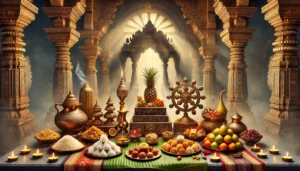
Mahaprasad recipe of jagannath temple
The Role of Prasadam in Devotional Practice
Prasadam holds immense spiritual and social significance in Sanatan Dharma. It fosters several virtues and practices, including:
Spiritual Connection: Offering food to the deities before consumption instills humility and gratitude, reminding devotees that all nourishment is a blessing from the divine.
Equality and Sharing: Prasadam transcends social barriers like caste, creed, and wealth, emphasizing equality in the eyes of God. Everyone, from kings to commoners, partakes in the same offering.
Purity of Ingredients and Mind: Temple foods are sattvic, meaning they are devoid of tamasic elements like onion, garlic, and artificial additives. Consuming such food promotes physical well-being and mental clarity.
Community Bonding: Temple kitchens and distribution of prasadam bring people together in devotion and service. Festivals and rituals often witness mass feeding, ensuring collective joy and harmony.
Other Notable Prasadams in India
Modak at Siddhivinayak Temple, Maharashtra: A sweet dumpling considered Lord Ganesha’s favorite offering.
Puliyodarai (Tamarind Rice) at Ranganathaswamy Temple, Srirangam: A tangy rice dish representing the deity’s blessings.
Kozhukattai at Meenakshi Temple, Madurai: Rice flour dumplings with jaggery and coconut.
Each temple prasadam holds a unique place in India’s cultural and spiritual tapestry, reflecting the regional traditions and the boundless grace of the deities.
Conclusion
Prasadam is not merely food—it is a sacred medium through which the divine blesses humanity. From the Tirupati Laddu to the Mahaprasad of Puri and the purifying Panchamrit, every offering reflects love, devotion, and purity. These foods nourish not just the body but the spirit, teaching humility, gratitude, and unity.
In a world dominated by material pursuits, the tradition of prasadam serves as a reminder of our spiritual heritage and the sanctity of food. It connects devotees across generations, uniting them in faith and service while symbolizing the eternal bond between the divine and the mortal. By partaking in prasadam, we embrace divine blessings, harmony, and the joy of Anna Brahma, the eternal grace of food.
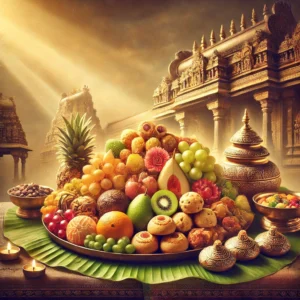
Mahaprasad recipe of jagannath temple
FAQs on “Prasadam: Sacred Temple Foods of India – Traditions, Recipes, and Spiritual Significance”:
- What is Prasadam in Hindu temples?
Prasadam is food or offerings that have been prepared and offered to the deity during worship at a temple. It is considered a divine gift from the temple’s deity to the devotees. Consuming Prasadam is believed to be a spiritual blessing that purifies the mind and soul, helping devotees connect more deeply with the divine.
- Why is Prasadam considered sacred?
Prasadam is sacred because it is consecrated or blessed during the worship process. The food is offered with reverence to the deity, and it is believed that consuming it allows the devotee to receive divine energy and blessings. The act of accepting Prasadam also symbolizes acceptance of God’s grace and the humility to receive His offerings.
- What are some famous Prasadam dishes in India?
India is home to many renowned Prasadam dishes, including:
Tirupati Laddu – Offered at the Tirumala Venkateswara Temple.
Mahaprasad – Distributed at the Jagannath Temple in Puri.
Panchamrit – Used in various temples as an offering.
Vada Prasadam – Served in temples across Southern India, especially in temples like the Rameswaram Temple.
Kozhukattai – A steamed rice dumpling, a favorite offering to Lord Ganesha.
- How is Tirupati Laddu prepared?
Tirupati Laddu is a traditional sweet made from besan (gram flour), sugar, ghee, and cashews. It is prepared with strict adherence to temple rituals and is believed to hold divine energy. It’s cooked in large quantities in the temple kitchens and is considered one of the most significant offerings to Lord Venkateswara.
- What is the significance of Mahaprasad at Puri?
Mahaprasad is considered the most sacred food offering in the Jagannath Temple of Puri. The food is prepared in large quantities, using wood-fired stoves in the temple kitchen. The Mahaprasad, once offered to Lord Jagannath, is believed to have spiritual powers, and consuming it is thought to bring purification, peace, and blessings.
- What is Panchamrit, and why is it important?
Panchamrit is a mixture of five sacred ingredients: milk, yogurt, honey, ghee, and sugar. It is traditionally offered to deities during various rituals and prayers, especially in temples and homes. It symbolizes purity, abundance, and the union of the five elements, and is considered to have both spiritual and medicinal properties.
- Are the preparation methods for Prasadam standardized?
The preparation methods for Prasadam are usually standardized, especially in large temples, where there are specific guidelines for cleanliness, ingredients, and ritualistic procedures. However, regional variations and temple-specific recipes may influence the ingredients or the cooking style, giving each temple’s Prasadam its unique characteristics.
- Can I prepare Prasadam at home?
Yes, many types of Prasadam can be prepared at home, especially for personal worship or during festival occasions. Recipes like Panchamrit, Laddus, and Kheer can be prepared following specific instructions, while ensuring the food is prepared with devotion and in a clean and pure environment. However, temple-prepared Prasadam holds a special significance due to its consecration by priests.
- Is it necessary to offer Prasadam during worship at temples?
Offering Prasadam during worship is a common practice but is not obligatory. It is considered an essential aspect of temple rituals, as it helps in forming a deeper spiritual connection with the divine. In many temples, Prasadam is offered directly after the worship and is shared as a means of receiving God’s blessings.
- What is the role of Prasadam in temple festivals?
During temple festivals, Prasadam plays a central role in the celebrations. Temples often prepare special offerings for festivals, such as large-scale meals, which are distributed to all devotees. Festivals like Diwali, Pongal, and Makar Sankranti see a wide distribution of Prasadam, symbolizing communal harmony and devotion. The special significance of Prasadam during these festivals is that it is believed to be blessed with heightened divine energy.
- Why is Prasadam distributed after a temple’s darshan (worship)?
After the darshan or direct viewing of the deity, Prasadam is distributed to the devotees as a mark of divine blessings. The food signifies that the devotee has been accepted by the deity and has received spiritual nourishment. It is a symbolic gesture that the devotee has been honored and that the deity has shared His grace and blessings.
- How is Prasadam connected to the concept of ‘Bhakti’ (devotion)?
Prasadam is a manifestation of the devotion (Bhakti) that is central to Hindu worship. By offering food to the deity and then receiving the blessed food, devotees demonstrate their humility and reverence. It signifies that they are accepting divine grace with a pure heart, reinforcing the devotional connection between the deity and the devotee.
- Is there a specific time when Prasadam should be consumed?
While there is no strict rule on when Prasadam should be consumed, it is traditionally eaten immediately after receiving it in the temple as a sign of gratitude and devotion. Some devotees also prefer to consume it at home after their ritual prayers or during specific festival periods when the Prasadam is considered to hold special blessings.
- How do different temples approach the preparation of Prasadam?
Different temples may have unique ways of preparing Prasadam based on their regional customs and the deities they worship. The temple’s priesthood often oversees the preparation to ensure that the food is pure and meets all religious requirements. In some temples, food is prepared by temple volunteers or workers in sacred kitchens, while in others, it may be cooked by dedicated cooks who follow sacred recipes passed down through generations.
- Can Prasadam be stored, and for how long?
Some types of Prasadam, like laddus or vadas, can be stored for a few days, provided they are kept in a cool and dry place. However, some offerings like Mahaprasad or fresh milk-based Prasadam are best consumed immediately as they are considered most sacred when freshly prepared.
- Is there a particular way to accept Prasadam in the temple?
It is customary to accept Prasadam with both hands, especially when it is offered by priests or temple attendants. Some temples also instruct devotees to consume it while sitting in the temple precincts to maintain the sacredness of the space. Respectful handling of the Prasadam is seen as a mark of reverence toward the divine blessing.
- How does Prasadam relate to Ayurveda and traditional healing?
In Ayurveda, food is considered medicine for the body, mind, and spirit. Many types of Prasadam, especially those made from milk, ghee, and honey, have properties that are believed to promote health and spiritual well-being. In the context of temple offerings, these ingredients are prepared in specific ways to support physical, mental, and spiritual healing.
- Is there a connection between Prasadam and Indian hospitality?
Yes, offering food to others is deeply rooted in Indian culture, and Prasadam reflects the tradition of hospitality. It signifies that the deity is offering nourishment and blessings to all who visit the temple, transcending individual needs and focusing on the well-being of the entire community.
- How do temple authorities ensure the purity of Prasadam?
Temple authorities maintain strict protocols for ensuring the purity and sanctity of Prasadam. This includes maintaining a clean kitchen, using only freshly prepared ingredients, and performing rituals before the food is offered to the deity. Many temples also ensure that the food is prepared in a spirit of devotion, often involving temple workers who are committed to serving with reverence.
- Can Prasadam be offered to the deities at home?
Yes, Prasadam can be prepared and offered at home as part of personal worship. While temple-based Prasadam is more common for public worship, many families prepare their own offerings, like sweets or fruits, during festivals or poojas. However, it is important to follow proper rituals and offer the food with devotion to maintain its sanctity.
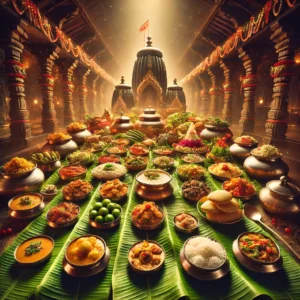
Mahaprasad recipe of jagannath temple
Summary
“Prasadam: Sacred Temple Foods of India – Traditions, Recipes, and Spiritual Significance”
Prasadam refers to food offerings that are consecrated during temple rituals and distributed to devotees as a divine blessing. These sacred foods symbolize spiritual nourishment and connection with the deity, offering blessings and purification to those who partake in them. Some of the most famous Prasadam dishes in India include Tirupati Laddu, Mahaprasad from Puri, Panchamrit, and Kozhukattai. Each of these foods carries deep religious and cultural significance, often tied to centuries-old traditions and specific rituals.
The preparation of Prasadam is a meticulous process, governed by strict religious guidelines to maintain purity and sanctity. In large temples, it is prepared in dedicated kitchens and offered to the deity with reverence before being distributed to devotees. The act of offering Prasadam is considered an expression of devotion (Bhakti), where the food becomes a conduit for receiving divine grace.
The spiritual significance of Prasadam goes beyond nourishment; it symbolizes acceptance of God’s blessings, and consuming it is believed to purify the mind, body, and soul. The sacredness of Prasadam is reflected in its ingredients, such as ghee, milk, and honey, which are considered auspicious in Hindu tradition. During festivals, temples prepare special Prasadam to share with larger communities, reinforcing the sense of divine grace and communal harmony.
In essence, Prasadam serves as a profound spiritual offering, reflecting the deep connection between food, faith, and tradition in Hinduism. It is not only a means of worship but also a way to experience divine blessings through the act of receiving and consuming sacred food.
Related Articles
- The Tridevi: Lakshmi, Saraswati, and Parvati – Their Roles and Powers
- “Divine Creatures of Ancient Indian Scriptures: Exploring the Role of Animals in the Vedas, Puranas, and Mahabharata”
- Nature and Spirituality: Exploring the Sacred Essence of the Himalayas, Ganga, and Other Natural Wonders”
- “Reviving the Gurukul System: Relevance and Lessons for Modern Education”
- “Exploring Greek and Indian Mythology: Similarities Between Greek and Indian Mythology “
- “Embracing Sattvic Living: Harmonizing Mind, Body, and Soul Through Food and Lifestyle”
- “Charity and Prosperity: Exploring the Concept of Daan and Its Financial Relevance in Modern Life”
- How to Build an Eco-Friendly Home Inspired by Vastu Shastra
- Comparison of Ancient and Modern Sports: How Traditional Sports Have Influenced Contemporary Games
- “Timeless Lessons from Ancient Tales: Linking Samudra Manthan and Ganga’s Descent to Modern Ecological Challenges”
- “Reviving Sanskrit: How AI is Preserving Ancient Languages for the Future”
- “Mathura: The Sacred Land of Lord Krishna’s Divine Leelas”
- Investing for Future Generations: Lessons from Indian Traditions on Legacy Building and Wealth Preservation
- “Ancient Indian Wisdom: Timeless Lessons for Tackling Today’s Climate Crisis”
- “Artificial Intelligence and Spirituality: Transforming Ancient Practices for the Modern World”
- “Gold and Real Estate in India: Timeless Assets Shaping Financial Strategies”
- “Divine Feminine Power in Hindu Mythology: The Legends of Durga, Saraswati, and Lakshmi”
- “Divine Beings of Sanatan Dharma: The Spiritual Significance of Sacred Animals in Hinduism”
- “Symbolism in Mythological Art: Unlocking Hidden Meanings in Ancient Temple Carvings”
- “Exploring Technological Advancements in Ancient India and Civilizations: Vimana, Metallurgy, & Water Management systems”
- Unveiling the Mysteries: Ancient Temples of Sanatan Dharma , Mysterious Temples of India
- “The Scientific Knowledge of Sanatan Dharma: Ancient Wisdom Meets Modern Science”
- Ancient Indian Sports and Games: Celebrating a Legacy of Skill, Strength & Strategy”
- “Exploring the Cosmic Link: The Connection Between Astronomy and Vedic Astrology”
- The Power of Sanskrit: Unlocking the Divine Language of the Gods
- “The End of Kaliyuga: A Sanatan Insight into the World’s Final Chapter”
- Explore more articles on Prachin Sanatan Yuga.
jagannath temple jagannath temple jagannath temple jagannath temple jagannath temple jagannath temple jagannath temple jagannath temple jagannath temple jagannath temple jagannath temple jagannath temple jagannath temple jagannath temple jagannath temple jagannath temple
jagannath temple jagannath temple jagannath temple jagannath temple jagannath temple jagannath temple jagannath temple jagannath temple
